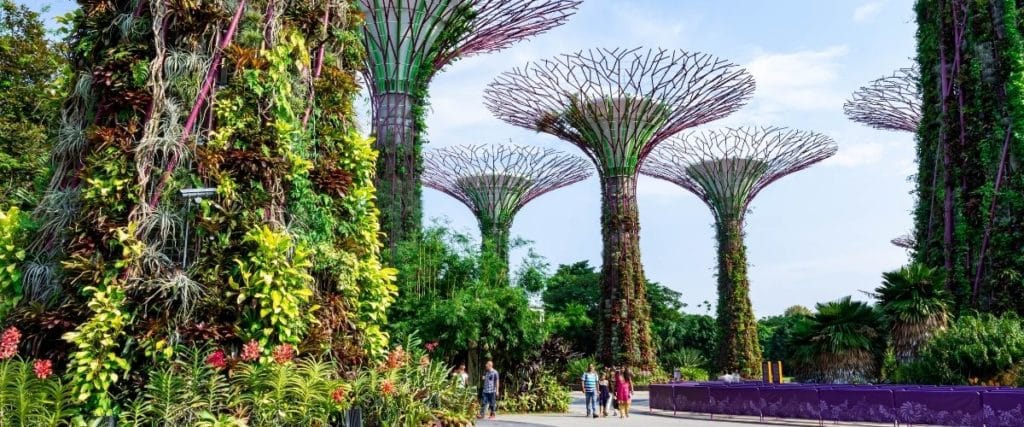Fast-paced urbanisation in APAC calls for the strengthening of innovation and investments in green infrastructure in order to build a sustainable ecosystem for the region’s pre-existing and emerging metropolises.
Encompassing around 60% of the global population, the Asia Pacific region (APAC) is home to some of the fastest developing subregions and populous cities. To cope with this rapid growth, surging demand and the need for urbanisation have become a prerequisite for Asian metropolises.
However, building urban cities as quickly as possible without taking sustainability into consideration is no longer an option; it is essential to strengthen urban policy frameworks to enable countries and cities to optimise their economic growth, environmental conservation, and social prosperity. Green infrastructure provides a city with ecological reform and economic resilience while ensuring longevity and sustainability in the transformation of land uses.
According to the Asian Development Bank, APAC requires up to US$1.7 trillion investment annually to facilitate the infrastructure gap, preserve its growth momentum, and combat climate change. As Asia shifts towards developing smart cities with integrated green infrastructures, it further opens up environmental, social, and governance (ESG) opportunities and investments to facilitate sustainable urban development.
What is Green Infrastructure?
Started as an international movement working towards building on natural resources and renewables for the regeneration of urban landscape and infrastructure, green infrastructure is referred to as the integration of natural systems with engineered ecosystems, to obtain a biodiverse and sustainable living environment in urban communities.
The model incorporates a range of water and environmental management practices, consolidation of green rooftops and buildings, streetside vegetation and gardens, and more, which work to rejuvenate the ecological biodiversity within a city. It allows countries and cities to reduce the environmental impact of human activities and impermeable infrastructure, by addressing and rehabilitating urban architectural landscape.
With the substantial growth and potential seen in green infrastructure, metropolises can effectively mitigate the effects of climate change and capitalise on long term sustainable solutions and innovations.

7 Ways to Build a Sustainable Ecosystem
1. Sustainable Wastewater Management
Surging water scarcity has made it necessary for cities to remodel their water supply and management systems. In order to meet growing demand, Asian countries have consolidated water conservation efforts by preserving natural water bodies and reclamation efforts.
To assemble the core of a green city, developing a sustainable wastewater management system is essential to better conserve water resources. Through a decentralised process of wastewater filtration, municipal wastewater (sewage), or industrial wastewater can be transformed into clean drinkable water.
Leading innovation and sustainability, Japan and Singapore are among the municipalities in APAC administrating domestic wastewater treatment systems in urban areas. The Johkasou system initiated in Japan is a tech-advanced treatment plant devised to filter domestic wastewater generated by local households and commercial buildings in a circular manner. The system sustains and repurposes wastewater to be reused multiple times, prolonging a city’s water supply conservation.

2. Green Buildings
The building construction industry in APAC is forecast to touch US$3.127 trillion by 2024. The demand for green buildings and rooftops has become increasingly popular in many Asian cities and are a key attribute to building a sustainable infrastructure within a city. These GreenTech innovations are designed by growing a top vegetative layer on a drainage-storage surface, facilitating rainfall infiltration and evapotranspiration of water stored, and fostering natural water circulation by repurposing rainwater harvested through the installations.
Incorporating such eco-friendly modifications into a building’s design is cost-effective and profitable in the long run, as it is proven to offset energy costs and stormwater management fees in the long run. Additionally, the flora and fauna form a regenerative natural habitat, which effectively lowers temperature fluctuations and urban heat islands.
In bustling Hong Kong, sustainability pioneer K11 leads by example with its lush greenscape, integrating over 70 sustainable elements in its infrastructure.

4. Renewable Energy
Air pollution is the major contributor to rising environmental issues in Asia. Transitioning to renewable energy effectively develops and promotes green infrastructure while minimising dependency on traditional energy sources, such as fossil fuels.
Clean energy comes from natural sources that are self-sustaining and replenishable. These power sources often heavily depend on time and weather, for instance, solar panels rely on sunlight, or electricity generation from wind turbines is dependent on wind flow. Clean energy grids being naturally renewable, contribute little to no greenhouse gas emissions.
Setting a precedent for neighbouring Southeast Asian cities, Singapore deployed floating solar-panel farms along the coastal area of the Johor Strait. The harboured 13,000 solar panels across the seabed have the capacity to power 1,500 flats for an entire year.

4. Urban Green Streets and Spaces
As more and more buildings emerge in cities, urban gardens add to the beauty of green infrastructure while offsetting the detrimental effects of urbanisation. Urban green streets and spaces consolidate eco-friendly, innovative, and economically viable architectural solutions. The model is facilitated through the installation of green infrastructure elements, such as permeable pavements, bioswales, planter boxes, as well as the planting of regional vegetation.
One of the greenest cities in APAC, 46.5% of Singapore’s urban land is green space, with over 30% with tree canopy coverage. Urban green landscaping constructively minimises temperature elevations, embraces biodiversity in nature, and improves the overall quality of living.

5. Green Transportation
Transportation in Asia has increasingly contributed to climate-warming greenhouse gases, so adopting a green transport system is critical for the sustainable development and infrastructure of a city.
Green modes of transportation reduce carbon emissions by alleviating fossil fuel consumption and replacing it with renewable alternatives, including wind or solar energy, hydroelectric, biomass, and other models.
Smart eco-friendly urban transport systems improve connectivity networks between rural and urban lands, reducing road congestion and promoting the integration of clean energy sources. Japan has the world’s best urban railway, with an advanced electric transport structure, and a well-mapped transit system. While Hong Kong has the most densely used road networks, this stimulates an innovative and connected metro network, making public transportation accessible and affordable for residents.

6. Nature and Biodiversity Conservation
Biodiversity defines the variability and coexistence of animals, plants, fungi, and other lifeforms in our habitat and natural ecosystems. Rapid urbanisation in Asia, however, limits biodiversity conservation in cities. Through landscape modernisation and reconstruction, biodiverse design can be implemented to drive green infrastructure and ecological robustness.
Enabling wildlife corridors, connectivity, and access to resources, work to conserve biodiversity in cities. In addition, cities can transition to organic greenery and vegetation maintenance, further utilising existing green spaces to engineer sustainable ecosystems.

7. Green Infrastructure Financing
As energy demand and ESG enforcement rapidly develop in Asian cities, they have successfully driven a new wave of financing opportunities within the sector. Green infrastructure projects have grown respectively, with up to US$13.7 billion allocated to renewable project financing in the APAC region in 2020. Governments and regulators are working to increase infrastructure financing, green bonds and loans, as well as strengthen sustainable development policies.
Hong Kong’s Government Green Bond Programme successfully administered RMB$5 billion in offshore renminbi green bonds in 2021, under the green finance initiative to consolidate low-carbon transition solutions in the region. Additionally, the Australian investment landscape has been increasingly active in renewable innovations as well as ESG-related projects, with strategic measures led by the Australian Sustainable Finance Institute (ASFI) to reshape the financial ecosystem.
Reinforcing these sustainable financing initiatives in Asia will positively stimulate emerging economies to scale their market presence, ESG framework, and green innovation.

Related Articles
APAC’s Smart Infrastructure Investments Will Boom in 2022
Inside Smart City Taiwan: A New Solution for Urban Living
Smart City Guide: 8 Key Features That Will Improve Society





